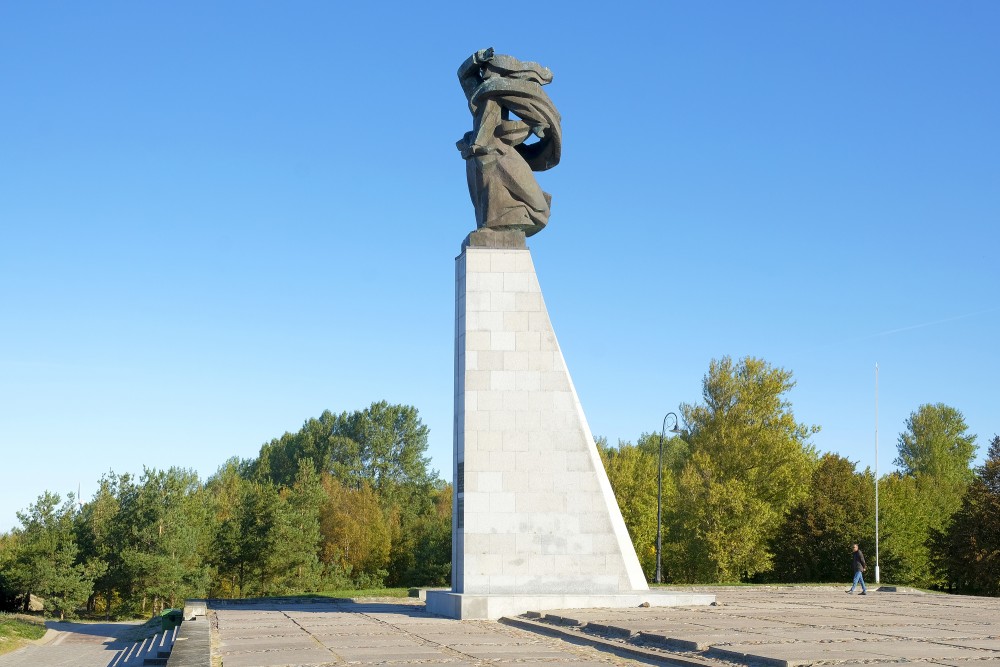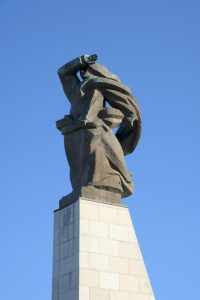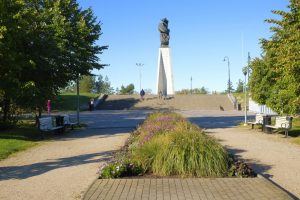Lesson Plans
Mother monument for sailors and fishermen who perished
Vēja māte - piemineklis bojā gājušajiem jūrniekiem un zvejniekiem Baltijas jūrā.
- Latvia
- Wind
- B1
Warming Up
- What can you see in the photo?
- What is a monument?
- Can you guess where the monument is standing?

Vocabulary
Cultural Heritage Background

 General information that helps us to understand the role of cultural heritage and the four elements:
General information that helps us to understand the role of cultural heritage and the four elements:
In Jurmala Park, there is an important monument dating from the year 1977. It’s there to honour the fishermen and sailors who died in the Baltic Sea. On the 11-metre-high base, which is made of dolomite from Saaremaa, there is a bronze statue of a woman. She looks sad and is mourning. She has her hand up over her eyes and is looking off into the distance. This is a symbol for all mothers, wives, brides, sisters, and loved ones whose men have not come back from the sea.
The town of Liepaja is known for its windy weather, especially at sea. Perhaps it is for this reason that the locals gave the monument the name “Wind Mother”. It is a popular spot for tourists to visit and locals often meet there before going to the beach together. The monument is an important modern attraction in Liepaja.

Liepaja is the third largest city in Latvia, with a population of around 86,000. The city is on the coast of the Baltic Sea and is surrounded by two lakes. The city started out as a small fishing village called “Villa Liva” in Latin. This village was mentioned in history books as early as 1253, but the city itself wasn’t built until 1625. Liepaja is often referred to as the City of Winds. This is because the wind, which most often blows from the west, is stronger than the average in the rest of Latvia. It is no wonder the city’s anthem starts with: “In the city where the wind is born…”
Listening
Listen to the story of the Liepaja town. Or read the text below out loud.
The town of Liepaja is known for its windy weather, especially at sea. Perhaps it is for this reason that the locals gave the monument the name “Wind Mother”. It is a popular spot for tourists to visit and locals often meet there before going to the beach together. The monument is an important modern attraction in Liepaja.
Listening Comprehension
Read the story
The Baltic Sea has a history of being a place of trouble dating back to the eighth century. For hundreds of years, people died in the sea because of the pirates who terrorised the coast and conflicts between countries competing for power in the region. During the Second Northern War, on November 8, 1658, the naval “Battle of the Sound” took place. The Dutch fleet was sent to stop Sweden from taking over both sides of the Sound (Øresund) and controlling access to the Baltic Sea as well as its trade. In the battle, the Swedes lost five ships and 439 men.
The sea connected many countries and was important for trade. The North Sea fleets in eastern England and the Netherlands needed Baltic timber, tar, flax, and hemp. Unfortunately, many deaths occurred there during wars.
In the Crimean War, the British and French attacked the Russian fortresses in the Baltic Sea. Later, Germany took control of the southern coast of the sea after unification in 1871. During World War I, the Baltic Sea was also a battleground.
When the Nazi party came to power, Germany occupied the Baltic states. In 1945, during World War II, the Baltic Sea became a mass grave for soldiers and refugees.
The sinking of the Wilhelm Gustloff is still the worst sea disaster ever. It was a German military transport ship that was sunk by the Soviet submarine on January 30, 1945, in the Baltic Sea. The ship was taking people from Gotenhafen (Gdynia) to safety as the Red Army advanced. One estimate says that 9,400 people died. The sinking of the Goya was one of the worst sea disasters of the war and one of the worst in history. Out of about 6,700 passengers and crew, only 183 people survived. During the war, the prison ship Cap Arcona also went down. It led to the deaths of more than 6,000 concentration camp prisoners on May 3, 1945. Both the German passenger ship “Cap Arcona” and the German cargo ship “Thielbek” were sunk by British bombers. They thought that the ships were carrying German troops.
A plaque on the “Wind Mother” monument honours the pilots and crew of a US plane that was shot down by the USSR military on April 8, 1950.
In winter, there can be bad storms in the Baltic Sea that can sink ships. On September 28, 1994, a cruise ferry “Estonia” sank claiming 852 lives. It was one of the worst accidents at sea in the 20th century.
The Baltic Sea is very important for the countries that border it. People love the sea and everything it offers, even though it can be dangerous and has a history of violence. The “Wind Mother” monument reminds us of the powerful natural forces that are always present in the Baltic Sea region.
Reading Comprehension
Grammar
Exercise 1. The text of the story includes a lot of past tense verbs as it progresses through the 8th and 20th centuries. Can you classify the following words into regular or irregular verbs?
Regular: base form + ed
Irregular: different forms
Additional activities
- Get to know the city of the winds! Watch this video on Youtube https://www.youtube.com/watch?v=JRfJVdof6f8 of a drone flying over the city of Liepaja. See if you can spot the “Wind Mother” monument! (3.37 min.)
- Watch these videos of storms in the Baltic Sea and write down a list of adjectives that come to mind when watching them https://youtube.com/shorts/nls8w7B8-fI?feature=share and https://www.youtube.com/watch?v=5O3zpWoE-HE
Extra resources for learners
- Links to 4 Elements in Arts Resource Library
- Read this article on how statues are made from bronze here
